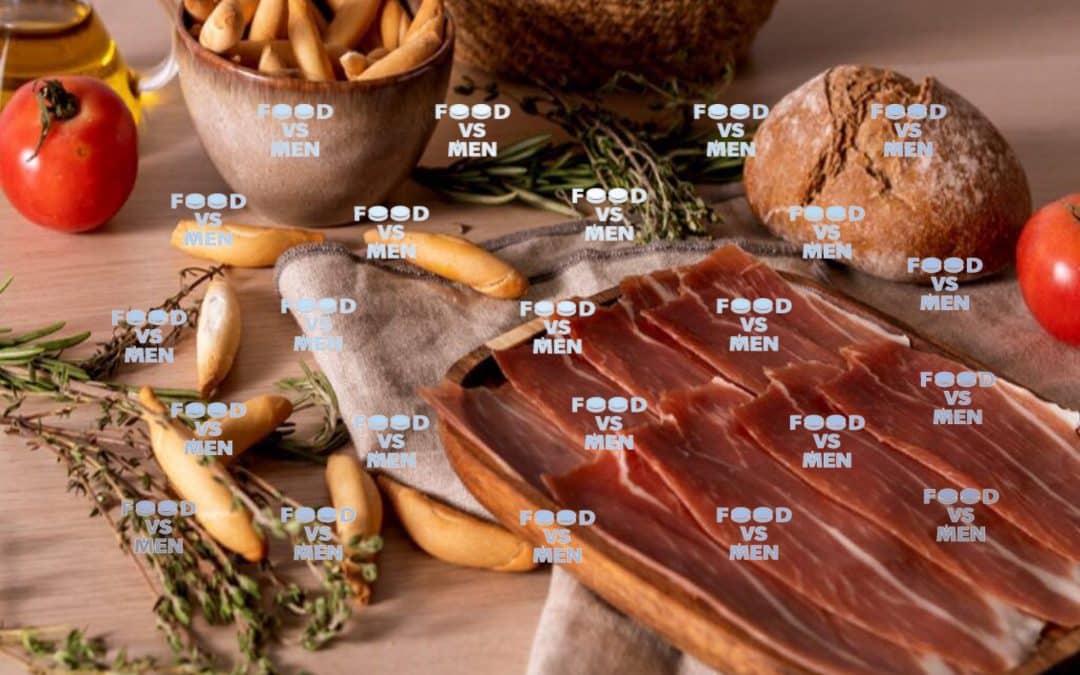What is Jamon Serrano ?
Jamon serrano is a type of Jamon, a dry-cured ham. It is made from the meat of white pigs, usually about six months old and weighing 200 to 250 pounds. It is cured for at least 36 months, often up to 48 months.
It is a type of Spanish ham that is cured and aged for a period of time. It is typically made from white Iberian pigs. The word “jamón” can be translated as “ham.” The word “serrano” means “from the mountains.” The region in Spain where this type of ham originates is known for its mountainous terrain. It’s a popular food item in the Mediterranean region. It has been around for centuries and people have been eating it since the 16th century. It may be smoked or not, depending on the desired flavor. There are many different types of serrano, with each ham having a unique taste and texture. Some are very salty, some have an earthy flavor, some have a sweet taste and some are dryer than others.

What is Jamon Serrano ?
History of Jamon Serrano
Jamon Serrano is a type of ham that is made from the hind leg of an Iberian pig. The name serrano is derived from the word “mountain” because this type of ham was traditionally produced in the mountains of Spain, where pigs were allowed to graze freely in oak forests. It is one of the most popular types of ham in Spain and Portugal, and it has been exported to many other countries around the world. It can be eaten as a cold cut in salads, as an appetizer Crudo with olive oil, and sea salt, or as part of a tapas dish.
Origin of the name
The word “Jamon” comes from the Latin “Jamma”, meaning “to soak,” while the word “serrano” means “from Seville.”Jamón Serrano means mountain country ham. The origin of the name is not very clear. It is believed that the name was created by a group of Spanish shepherds in the region of Andalusia, who were trying to imitate the sound that pigs make when they were eating.
What is jamón serrano in English?
The term jamón serrano (“serrano ham”, ham from the sierra or mountain range) is routinely applied as an umbrella culinary term for all dry-cured jamón produced in Spain, as opposed to jamón de York, which is cooked entirely on the bone.
How Jamon Serrano became the King of Spanish Icons
Jamon Serrano is a Spanish chef, who is known for his unique style and recipes. He has been in the industry for more than three decades and has won many awards. Born in 1966, He was raised in a family of restaurateurs. After graduating from culinary school, he became the chef at his parents’ restaurant where he learned about cooking. In 1994, he opened his own restaurant, El Jardin del Jamón Serrano.
In 2001, he won first prize at the International Cooking Competition of San Sebastián with his dish “Olla de Guisantes con Jamón de Jabugo.”
Which country is famous for Jamon Serrano? This food is the most famous in Spain. It is very popular in Barcelona. Ham production in Spain has been around for centuries and has a long tradition dating back to Roman times. Spain is the country that produces Jamon serrano.
Prosciutto VS Jamon Serrano Prosciutto and ham are two types of meat that are very similar in many ways. They are both salty, cured types of meat that are usually eaten as an appetizer or a main course. One of the main differences between prosciutto and ham is that prosciutto is usually dried with salt and nitrate before it is put into a cask to age for weeks or months.
Serrano ham is a type of cured meat that is made from the hind leg of a pig. It is dry-cured with salt, pepper, garlic, and other spices. Prosciutto is an Italian dry-cured ham that has been seasoned with salt and spices. Prosciutto can be served fresh or cooked and it has a tender texture because it has been dried rather than cured in brine like Serrano ham. Serrano ham can be eaten as part of a sandwich or on its own, whereas prosciutto is more often used as an ingredient in other dishes such as antipasto or pasta dishes. Pork leg is cured with salt, pepper, garlic, and other spices to prevent spoiling. The meat is then dried in a cold environment, resulting in a dry-cured less juicy ham that has a familiar yet more intense flavor than wet-cured hams. Serrano ham is saltier and spicier than prosciutto which is typically served as part of an antipasto or pasta dish.
Prosciutto Vs. Serrano Vs. Ham
Prosciutto, also known as Parma ham, is dry-cured meat made from either the thigh or leg of pork and sometimes beef. It is salt-cured and matured for 2-3 months to achieve its distinctive flavor and texture. The word prosciutto comes from the Latin “prōsciūtus” meaning “ham.”
The flavor of serrano is more intense and richer than prosciutto. Serrano ham is a type of Spanish dry-cured ham that is usually served as a tapa. It has a more intense flavor and richness than prosciutto, but it also has a less fat content. The word “Serrano” refers to the sierra or mountain range in Spain where the pigs are bred for this type of ham. Serrano ham is made from the hind leg of the pig, and it is cured using salt and nitrites, like other dry-cured hams. Salt retards bacteria; nitrites give Serrano ham its pink color. The process for making Serrano ham may take up to two months, during which time the carcass is laid on a special rack that allows air to circulate freely around it. The final product weighs around three kilos (6 pounds). The flavor of Serrano is more intense and richer than prosciutto. Served as a tapa Serrano ham has a more intense flavor, with less fat content, than that of traditional prosciutto. Тapas are served in small quantities and typically have an olive or cocktail napkin around them to catch any drips.
How to make Jamon Serrano
- It’s a type of cured ham that has been dry-cured and air-dried.
- It is made from pork meat, usually cut from the leg or shoulder, which is then rubbed with salt and a mixture of seasonings.
- The meat is then allowed to cure for several months before being placed in front of a fire or in a smokehouse.
The process of making this food is a long and complicated one. It requires a lot of patience and precision. The flavor of the meat is determined by the type of pig that it comes from. The best type to use for this recipe is Iberian ham, which has been dry-cured for at least two years. The first step in making serrano is to purchase a whole Iberian ham, which will be cut into two pieces. One piece will be used for the loin and the other piece will be used for the shank end or butt end of the ham. The loin will be cut into cubes while the butt end will need to have its skin removed with a knife before being quartered into squares called lonjas. After these preparations are done, you can start with your curing process by rubbing salt onto both pieces that you have cut from your whole Iberian ham. You should rub it evenly on each. Serrano Ham is made from the hind leg of a pig. The meat is cured in salt, sugar, and other spices for up to 18 months. The meat is then air-dried for 3-6 months before being sliced very thinly and served cold.
How To Taste Jamon Serrano
The Spaniards have a saying “jamón serrano, buen asador”. This means that ham is not just for eating, but also for cooking. It has a subtle sweetness and a deep saltiness that can be used to enhance the flavors of other foods such as sauces and vegetables. Ham is a popular holiday and party appetizer, but it can be tough to figure out how to serve it. There are many types of hams, and serving them properly can be difficult. A lot depends on the type of ham you’re serving and what you’re pairing it with.
What do you drink Serrano ham with?
Spain’s fresh white wines are also a good complement to Serrano ham, especially the Albarino and Verdejo varieties. The bold wines of Ribeira del Duero, Toro, and Rioja compliment the dark-flavored Iberico ham in autumn and winter, while the full flavors can warm your soul.
Does Pig Meat Make You Fat?
Pigs are not the most popular animals in the world. They are called dirty, stinky, and greedy. But what does science say about this? Is pig meat healthy for you? Pigs have a reputation for being dirty, but they’re actually very clean animals. They’re also intelligent and social, much like dogs and cats. In fact, pigs are so smart that they can be trained to perform tricks!
Pigs don’t have sweat glands on their skin to cool themselves off when it’s hot outside. Instead, they rely on mud baths to keep cool in the summertime!
The meat from pigs is often considered unhealthy because of its high-fat content, but studies show that pork is actually healthier than beef or chicken. It contains more protein than beef and less fat than chicken or turkey.
Why is this ham not allowed in the US?
Serrano ham is not allowed in the US because it contains the dangerous bacteria that cause botulism. A long-term ban on imports of Spanish pork products can be traced to cases of African swine fever in Spain, which can infect domestic pigs. But, satisfied that Spanish pork is safe, the USA ban will be gradually lifted over the next year or so. However, this has to do with protecting the US pork industry, which values quantity over quality. They could raise good quality pigs here and develop Spanish-style curing techniques. But the industry doesn’t want to change its cheap model and they probably don’t think it will catch on in the US market.so, they keep making sub-par hams that are injected with saline and are brighter and saltier than Serrano.

jamon serrano
What are the Health Benefits of Eating Jamon Serranos?
The health benefits of eating serrano are plentiful, including some surprising ones! One benefit to this meat is that it contains high levels of protein, which helps regulate blood sugar levels and boosts metabolism. The fat in this meat also contains omega-3 fatty acids which have been found to improve brain function and reduce inflammation in joints.
How to Serve Jamón Serrano in a Tapa Style Cuisine
Tapas is a Spanish dish that is served in small portions. It is an appetizer and it can be eaten with bread. Tapas are often served with wine or beer, and the dishes are usually shared among friends at a table. Tapa-style cuisine consists of dishes that are cut into small pieces or slices before they are served. This style of cuisine originated in Andalusia, Southern Spain, but it has spread to other regions as well.
The tapa-style cuisine has been influenced by the culture and ingredients of the countries to which it has been introduced, which include France and Japan. The word “tapas” means “lid” in Spanish, which is why you will see these dishes being served on small plates or lids made out of bread or pastry dough. Tapas can be enjoyed by individuals as well as groups because they can be shared among friends at a table.






